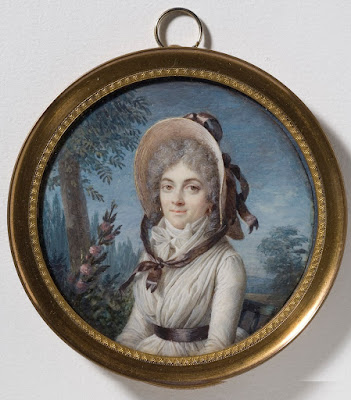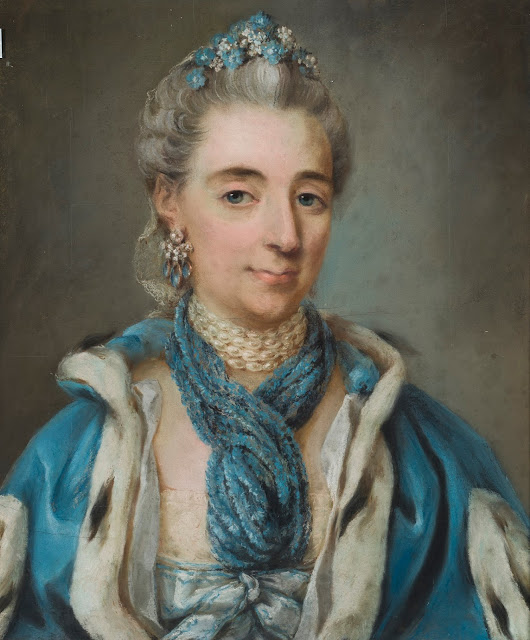 |
| Carl Gustaf Klingstedt Miniature painting of Satyr, Maenad and two Fauns 1713 watercolor on ivory Nationalmuseum, Stockholm |
 |
| Carl Plötz after Christian Gottlieb Kratzenstein-Stub Cabinet miniature of Ossian and the Son of Alphin listening to the Spirit of Malvin ca. 1816 gouache on ivory Nationalmuseum, Stockholm |
Directly above, one of the innumerable illustrations made across Europe in the late 18th and early 19th century for the cycle of epic poems supposedly written in Gaelic in the 3rd century by a bard known as Ossian. These were first published in an English "translation" by the Scottish poet James Macpherson (1736-1796), and were in fact composed by him, as many contemporary critics suspected from the outset. The controversy over the authenticity of the Ossian poems raged on in print over the course of several decades, until the fashion for romantic antiquarianism itself began to expire.
Son of noble Fingal, Ossian,
Prince of men! what tears run down
the cheeks of age? what shades thy
mighty soul?
Memory, son of Alphin, memory
wounds the aged. Of former times
are my thoughts; my thoughts are of the
noble Fingal. The race of the king return
into my mind, and wound me with
remembrance.
 |
| Robert Thorburn Miniature portrait of Mrs Georgina Maria Grenfell before 1885 watercolor on ivory Nationalmuseum, Stockholm |
 |
| Giovanni Domenico Bossi Miniature portrait of Colonel Georg Skjöldebrand and his sister Maria Elisabeth before 1816 watercolor on ivory Nationalmuseum, Stockholm |
 |
| Giovanni Domenico Bossi Miniature portrait of Lieutenant-General Carl von Cardell 1797 watercolor on ivory Nationalmuseum, Stockholm |
 |
| Giovanni Domenico Bossi Miniature portrait of Frederica Charlotta Stenbock 1799 watercolor on ivory Nationalmuseum, Stockholm |
 |
| Giovanni Domenico Bossi Miniature portrait of Count Carl Henrik Posse 1799 watercolor on ivory Nationalmuseum, Stockholm |
 |
| Thomas Frye Miniature portrait of unknown man before 1762 watercolor on ivory Nationalmuseum, Stockholm |
 |
| John Engleheart Miniature portrait of unknown woman in Renaissance costume before 1828 watercolor on ivory Nationalmuseum, Stockholm |
 |
| John Bogle Miniature portrait of unknown man 1775 watercolor on ivory Nationalmuseum, Stockholm |
"The miniature was one of the first portrait forms to be coveted by the bourgeoisie for the expression of its new cult of individualism. In dealing with this new clientele, the portrait painter faced a double task: he must imitate the style of the court painters, and bring down his prices. "Portrait painting in France at the time of Louis XV and Louis XVI is characterized by a tendency to falsify, to idealize each face, even that of the shopkeeper, in order to have him resemble the exemplary human type: the prince." Easily adapted to its new clientele, the miniature became one of the most successful minor arts. A miniaturist could support himself by turning out thirty to fifty portraits a year and selling them at moderate prices. But even though it was popular among the middle classes for a time, it still retained its aristocratic elements, and eventually, as the middle classes became more secure, it died out. By 1850, when the bourgeoisie had become firmly established, the miniature portrait had all but disappeared, and photography deprived the last of the miniaturists of their livelihood."
– Gisèle Freund, from Photography & Society (1970)
 |
| Henri Benner Miniature portrait of Charlotte Margarete von Liewen 1821 watercolor on ivory Nationalmuseum, Stockholm |
 |
| Frederick Cruikshank Miniature portrait of Elizabeth Evans 1826 watercolor on ivory Nationalmuseum, Stockholm |
 |
| Ozias Humphry Miniature portrait of British officer in India 1786 watercolor on ivory Nationalmuseum, Stockholm |
 |
| Nathaniel Hone Miniature Self-portrait 1763 watercolor on ivory Nationalmuseum, Stockholm |









































